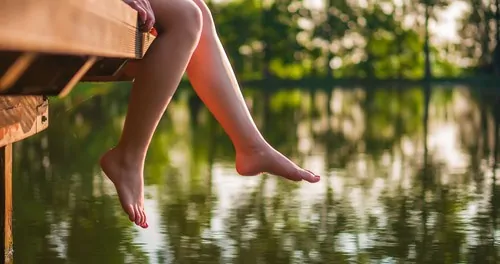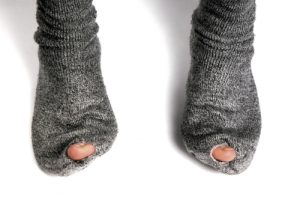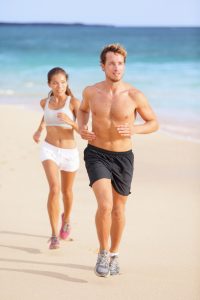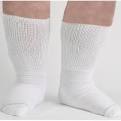Best Running Socks

Beaver Valley Foot Clinic
 Best Running Socks
Best Running Socks
Cushioning is a key part of what shoes do during a workout, and good athletic socks can help. Especially if you’re a runner, the best running socks have a thicker, shock absorbing bottom. While you’ll probably want to wear lighter socks during competition, thicker varieties of the best running socks provide much more shock absorption. When combined with proper footwear this plays a role in preventing overuse injuries such as stress fractures.
Best Socks
Buying new socks? Put down the cotton.
Ever been paralyzed by the sheer number of choices you have when shopping for sports-specific shoes? We can’t simplify your shoe buying experience, but we can offer you some solid advice on socks. They’re the other half of what you put on your feet, and they’re something many athletes ignore entirely.
It’s no secret that athletes face many foot problems, ranging from blisters to broken bones. Shoes provide protection, support, shock absorption, and moisture control. In short, they’re essential and can greatly reduce the risk of many foot problems.
What’s not generally acknowledged is the role of socks. While not as critical as shoes, the best running socks provide many of the same functions.
How about material for the best running socks?

The three main choices are cotton, wool, and several types of synthetic fabric. It’s true that cotton “sweat socks” have been the traditional choice for generations of athletes. Today, however, synthetic fabrics are generally superior and almost always the better choice.
But what about wool? While wool is certainly no high-tech synthetic it often performs just as well.
Cotton socks, especially well-worn pairs, have a tendency to bunch up in places. This is almost entirely avoidable by ditching cotton in favor of other materials. This isn’t just a comfort issue. Bunched up material doesn’t offer even, uniform protection against friction and abrasion. This can make a difference in any sport, but is especially important to distance runners.
Cotton also falls short in moisture protection, often referred to as wicking. The long, absorbent fibers found in cotton act as tiny sponges. They not only won’t keep your feet dry, but will actively hold sweat against the skin. Synthetic fibers absorb moisture too, but carry it away from the skin via a “wicking” effect. Note that wool provides this function just as well.
While you’ll certainly pay less for cotton, it’s best to go with 100% acrylic or a good synthetic blend. They’ll cost more up front, but will hold their shape and usually last much longer. They’ll also help you stay dry, provide better cushioning, and repel odor.
General guidelines when buying the best running socks:
· High quality socks are especially important to runners: Bunched up, soggy cotton socks certainly won’t add to one of your longer runs. They’ll also hold moisture against your feet which can greatly increase your chances of athlete’s foot (tinea pedis). They can also contribute to fungal infections of the toenails (onychomycosis).
· The same applies to hiking: while synthetic socks are a good option, many veteran hikers prefer wool. This natural fiber provides good wicking and an unmatched cushioning effect. What’s more, wool is one of the few materials which hold in heat when wet. It’s also naturally odor resistant. Wool is an excellent overall choice, especially for cold temperature hikes.
· Cycling: thin synthetic socks are probably your best bet. They weigh virtually nothing and efficiently wick away moisture. Synthetic cycling socks often have a slippery feel as well, which can reduce friction and chafing.
· Lifting: sock material isn’t as important for strength training. Many trainers recommend wearing socks which cover the shins, however. This can prevent scrapes and bruises when performing bar exercises such as dead lifts.
Regardless of what you’re buying socks for, don’t go cheap. Choose a high quality acrylic, synthetic blend, or wool sock. These options will not only last longer, but your feet will thank you!
Best Socks for Diabetic Patients
As a group, no one suffers more foot problems than individuals with diabetes. In light of this, many podiatrists prescribe diabetic socks. When used consistently, they offer several health benefits which can greatly contribute to overall foot health.
There’s really no downside to wearing diabetic socks, and according to podiatrists most diabetics should wear them. If minor blistering occurs from socks that are too tight the answer is simple—get larger socks. If larger irritations or even small ulcers begin to appear tell your podiatrist immediately.
Buying the best running socks
Almost anything can be bought online today, and diabetic socks are no exception.
While it is possible to get good deals at medical supply stores, shopping online is usually your best bet. Prices are generally lower, they’re delivered right to your door, and the selection can’t be beat.
Amazon.com is a great place to start. This online mega-retailer allows 3rd party companies to sell directly to you, eliminating the middle-man. All of these manufacturers are competing for your business as well, and this pricing war definitely works in your favor. If you prefer to try before you buy the answer is simple. First, find a pair you like at a bricks and mortar retailer. If you’re fully satisfied, buy them online next time.
Amazon also features user reviews. These aren’t paid ads, and can help you greatly in the decision making process. This is something you simply can’t get at a physical retail location. It’s also one of the main reasons millions of people prefer to shop online.
Still not done shopping? Hundreds of other sites which are competing with Amazon are just a click away. Take 10 minutes to check out a few more retailers and you may find an even better deal.
Best Compression Socks for Nurses
The nursing profession presents special challenges which make compression garments almost mandatory. Very long shifts standing on hard surfaces, combined with long periods of sitting, are the norm for most nurses. Experiencing symptoms such as achiness and heaviness of the legs, fatigue, and swelling is almost a given.
This being said, it’s a good idea for most (if not all) nurses to wear compression socks. They provide symptomatic relief, reduce lactic acid buildup, and help bring oxygenated blood back into the legs. Over time, wearing good compression socks can prevent these hardworking health care professionals from developing unsightly varicose and spider veins. It’s a simple solution, and many nurses who didn’t wear compression socks early in their careers reach a point where they wish they had. If you’re a nurse, high quality compression socks are a great way to tell your legs you love them!
For a running doctor near me call Beaver Valley Foot Clinic today and get personal recommendations for your best running socks recommendations
Will Running Socks Make Difference In Recovery After A Run?
Yes, running socks can make a huge difference in recovery after a run, especially the compression running socks, here’s how:
1. Better Circulation: All sorts of compression garments promote a healthy blood flow, and compression socks are no exception, which helps them deliver oxygen and nutrients to muscles, while waste products are removed, this makes the recovery process even faster.
2. Reduced Swelling: Since compression stockings apply pressure on swelling, they reduce which also helps dealing with inflammation in the feet and calves which can be caused by prolonged running.
3. Muscle Support: Wearing well-fitted and compression socks will provide you gentle support to the tired muscles, which minimizes the post-running soreness.
4. Moisture-wicking: If your socks are moisture-wicking ones then they will absorb the sweat which leafs to reduced risk of irritation, blisters, fungal infections all of which can interfere with your recovery.
If I wear Wrong Running socks, Does It Contribute To Foot Pain?
Yes, if you wear wrong running socks, you can experience foot pain, here’s how it goes:
1. Blisters and Friction: If your socks are made of cotton and aren’t able to wick-moisture then it can increase the chances of friction and cause blisters.
2. Poor Cushioning: Wearing socks that are thin and aren’t cushioned then they may not be able to absorb impacts which leads to discomfort during long runs and might even lead to plantar fasciitis and other foot related problems.
3. Improper Fit: Wearing shocks that are too tight or don’t fit you well will restrict your blood flow, which can make healing difficult. While loose socks might lead to irritation or rubbing.
4. Inadequate Protection: Socks without reinforced heels and toes can fail to provide enough padding in high impact areas, which leads to soreness.
Should I choose cushioned or thin running socks?
The choice between cushioned or thin running socks depends on your personal preference and comfort level.
- Cushioned Running Socks: These socks provide extra padding and support, making them suitable for runners who prefer additional cushioning, especially during long runs. They can help absorb impact and reduce the risk of blisters.
- Thin Running Socks: Thin socks are lighter and offer a more minimalist feel. They are breathable and wick moisture away from your feet, making them a popular choice for runners who prefer a snug fit and a lightweight feel. Thin socks are often favored in hot weather or for races where lightweight footwear is essential.
Ultimately, the best choice depends on your individual comfort, the type of running you do, and the specific conditions you’ll be running in.
How often should I replace my running socks?
The lifespan of running socks varies based on factors like the quality of the socks, how frequently you wear them, and how well you care for them. As a general guideline, it’s a good idea to replace your running socks every 300-500 miles of running or when you notice signs of wear and tear.
Common signs that your running socks might need replacement include thinning of the fabric, loss of elasticity, development of holes or excessive pilling, and a decrease in cushioning or support. Worn-out socks may not provide the necessary comfort and support, increasing the risk of blisters and discomfort during your runs.
Are moisture-wicking socks important for runners?
Yes, moisture-wicking socks are crucial for runners. They are designed to draw sweat away from your skin, keeping your feet dry and reducing the risk of blisters and discomfort. By wicking away moisture, these socks help maintain a comfortable environment, enhance performance, and minimize the chances of fungal infections or other foot-related issues during prolonged physical activity.

 Best Running Socks
Best Running Socks
